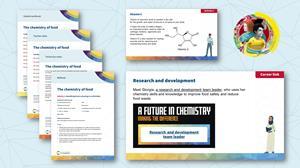Analyse food and drink samples using TLC, titration and visible absorption spectroscopy
This project should take approximately five hours to complete in full, but you could extend this if you add molecular modelling practice. The activities were initially created for 14–16 year-old learners but can be adapted for other age groups.
Use the resource in a sequence of timetabled chemistry lessons, STEM clubs or during an activity day.
Learning objectives
- Carry out at least two analytical procedures successfully to obtain reliable results.
- Use a minimum of one set of results to calculate an unknown quantity.
- Summarise at least two careers linked to food that use chemistry.
Guidance notes
Use the PowerPoint to introduce and provide the background science to each of the three practical activities. Carry out the food analysis experiments as a circus of three stations with small groups or pairs of learners circulating after approximately one hour at each station.

This resource was developed as part of the Chemistry for All project. The project was set up to explore and address barriers to participation in UK chemistry undergraduate study through a longitudinal project. Read the findings relevant to teachers, outreach providers, education policymakers and parents in the summary report, or download the full research report.
Activity 1: identifying food colourings in soft drinks
In Activity 1, learners find the Rf values of a range of food colourings through thin-layer chromatography (TLC). They then analyse concentrated extracts from soft drinks to find which food colourings are present by comparing the Rf values. Once learners have completed the practical work, they summarise their findings in a memo to a drinks manufacturer. This consolidates their learning and focuses on the career of a food analyst.
Activity 2: finding the vitamin C content of fruit juices
Learners use the reaction between iodine and vitamin C to find the vitamin C content of fruit juice in Activity 2. They carry out a titration, then use their results in structured calculations to determine the vitamin C concentration in the juice.
In their role of food analyst, they write to the juice manufacturer to explain their results with reference to claims on the juice’s nutritional labelling.
Activity 3: finding the iron content of food
Visible absorption spectroscopy is used to find the iron content of some food samples. Learners produce a calibration curve using standard iron solutions, then use this to find the iron content of the unknown samples.
If you do not have the kit available you could skip this activity or use an alternative, such as Project 2: phone-y science. This allows learners to use an alternative to a spectrophotometer and you could adapt it for testing iron solutions instead of different blackcurrant concentrations.
Challenge activities
Use current news items or reports for learners to read about teenage diets (eg too much sugar or caffeine; not enough iron/vitamins and so on). Learners could write their own summary articles and make suggestions for policymakers.
There are two questions, one on titration and one on chromatography, in the student workbook that learners could complete as an extension or homework activity.
Find the answers to all the activities in the teacher notes and on the slides.
More resources
- Watch the Paper chromatography practical video to review how to separate mixtures, produce a paper chromatogram and calculate Rf values from learners’ results.
- Highlight Giorgia’s career as a research and development team leader. She uses her chemistry skills and knowledge to improve food safety and reduce food waste.
- Learn how cooking affects the vitamin C content in cabbage with this investigative experiment for 16–18 year-old learners.
- Use the Edible experiments series to discover the importance of chemistry in more everyday eating experiences.
Careers
The Chemistry for All project found that recognising the value and importance of chemistry, and appreciating how it can lead to interesting and well-paid jobs strongly related to learners’ future aspirations.
Use the videos embedded in the PowerPoint to introduce learners to four scientists who use their chemistry skills, knowledge and qualifications in their careers. Share our careers website, A Future in Chemistry, with learners to discover the different study options available to them, find more job profiles of chemists making a difference and try our career options game.
Health and safety
Read our health and safety guidance and carry out a risk assessment before running any live practical.
The safety equipment suggested is in line with CLEAPSS requirements. For non-hazardous substances, wearing lab coats can help to protect clothes. The safety rules might be different where you live so it is worth checking local and school guidance. Remind learners they should never eat or drink in a science laboratory.
Find more projects like this, plus shorter activities suitable for single science lessons or clubs on our Outreach resources hub.
Downloads
The chemistry of food student workbook
Editable handout | Word, Size 0.64 mbThe chemistry of food student workbook
Handout | PDF, Size 0.67 mbThe chemistry of food method sheets
Editable handout | Word, Size 0.65 mbThe chemistry of food method sheets
Handout | PDF, Size 0.62 mbThe chemistry of food teacher notes
Editable handout | Word, Size 0.49 mbThe chemistry of food teacher notes
Handout | PDF, Size 0.66 mbThe chemistry of food technician notes
Editable handout | Word, Size 0.73 mbThe chemistry of food technician notes
Handout | PDF, Size 0.46 mbThe chemistry of food presentation slides
Presentation | PowerPoint, Size 2.09 mbThe chemistry of food presentation slides
Presentation | PDF, Size 1.5 mb
Additional information
This resource was originally developed by Liverpool John Moores University to support outreach work delivered as part of the Chemistry for All project.
Chemistry for All project resources
- 1
- 2
- 3
- 4
- 5
 Currently reading
Currently readingThe chemistry of food
- 6





















No comments yet